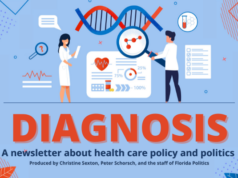
Welcome back to Diagnosis, a vertical that focuses on the crossroads of health care policy and politics.
Florida’s foray into a post-Roe world will have taken its first steps Monday when a circuit judge holds a hearing on whether to block the state’s recently enacted ban on abortions after 15 weeks.
The measure signed into law by Gov. Ron DeSantis is scheduled to take effect Friday — exactly one week after the U.S. Supreme Court struck down the 50-year-old ruling that had allowed abortion to be legal nationwide.
However, the case before Circuit Judge John Cooper isn’t predicated on that federal ruling. Instead, those challenging the new state law, including Planned Parenthood chapters and several abortion clinics, are basing the lawsuit on Florida’s right to privacy clause enacted by voters.

In a landmark 1989 case, the state Supreme Court concluded that privacy rights extend to abortion restrictions.
In a response filed this past Friday, attorneys for the abortion clinics say that the state continues to ignore past Supreme Court rulings that the state constitution contains a “fundamental right” to terminate a pregnancy before viability without government interference. They stated that the argument that many people can continue to get abortions “defies common sense and decades of Florida Supreme Court precedent. They say a ban on abortions after five weeks would be valid under that logic. “Plainly, that is now the law,” states the brief.
Whatever happens in Cooper’s court will just be the opening round in a legal battle that will (ultimately) wind up before a state Supreme Court, which DeSantis has overhauled.
Diagnosis won’t be published next week, but it will return July 11. Have a happy and safe 4th of July.
I welcome your feedback, questions and especially your tips. You can email me at SextonHealthNewsletter@gmail.com or call me at (850) 251-2317.
The state did not overstep its authority this spring when it proposed changing how regulators determine whether there is a need for new hospice programs.
Moreover, Division of Administrative Hearings Officer Lawrence P. Stevenson concluded that the move by regulators to limit the industry’s ability to challenge the projected “need” for new hospice programs to instances of state-made mathematical or data input errors was not arbitrary or capricious.
In doing so, the proposed rule amendments would preclude hospices from challenging the need calculations based on erroneous census information reported to the state. The industry argued that bad data could result in finding a new need for services where none exist.
For its part, the state Agency for Health Care Administration argued that it wanted to bring finality to the need determination process and prevent hospices from manipulating the data they submit to avoid increased competition.

“All involved parties do their best to provide the most accurate data possible, but AHCA has recognized that a perpetual chase after perfectly “correct” numbers can lead to diminishing returns and wasted effort, if not chicanery,” Stevenson wrote in a 40-page opinion. “At some point, a line must be drawn under one batching cycle so that all concerned may move on to the next.”
In 2019, the Florida Legislature eliminated most hospital projects from certificate of need review. But the state still relies on the licensure program for new nursing homes, hospice, and intermediate care facilities for the developmentally disabled.
To that end, AHCA reviews whether there is a need for new services twice a year and publishes the projected demand. In determining whether new hospice services are needed, the agency examines whether the actual number of hospice patients in the 27 different planning areas across the state is keeping pace with the statewide proportion of patients who choose to use hospice services.
If the number of expected patients in a service area exceeds the statewide proportion of patients by 350, there is a “need” for a new program.
In making those calculations, AHCA relies on utilization report data submitted by the industry to the state twice a year. The reports track patient admissions, among other things.
The final order notes that during a two-day hearing, testimony “established that it is not uncommon for a hospice to discover an error in its reported admissions after the fixed need pool has been published” and that hospices submit corrected reports notifying AHCA of the mistake.
AHCA testified in administrative court that there was no way for it to “substantively review the accuracy of a hospice’s submitted data.” The agency also argued that it had “no recourse under the current rule but to accept an amended report” and to “recalculate and republish the fixed need pool if the amended report would alter the determination of need in any service area.”
The industry argued that the proposed changes would upend a process that for 30 years has worked well for the state and the industry. And Stevenson noted in his order that James McLemore, Unit Manager of AHCA’s CON Unit, “did not appear completely persuaded of the wisdom” behind the proposed changes.
“Nonetheless, the undersigned does not find that the proposed amendments are arbitrary or capricious. AHCA is fully aware that its proposed amendments bear the possibility of incorporating incorrect information into its fixed need pool projections. AHCA has articulated a rational basis for the amendments,” Stevenson wrote. “ In practice, the negative possibilities cited by Petitioners may come to pass and outweigh the benefits anticipated by AHCA. However, (the law) includes no prohibition on an agency’s making a mistake. “
The final order in the case came as AHCA announced decisions on the latest round of CON applications for hospice programs.
— CON transfers, delays and increased costs —
It’s been three years since the state first approved a certificate of need application for a new 61,000-plus square foot, 67-bed nursing home in Hillsborough County slated to begin offering service in May 2021. Since then, the coveted CON has been transferred (with state approval) twice, the costs of the facility have soared by more than $2 million, and the opening date has been pushed back by three years.
A review of CON applications shows the transfers have been among entities affiliated with Briar Hill Management, LLC, a Mississippi-based health-care-services management company that manages six Mississippi skilled nursing facilities.

AHCA published a notice last week that it had approved an expedited CON application requesting approval of the transfer of CON # 10641 from Sabal Palm Health and Rehab Center, LLC to Riverview Nursing and Rehab Center, LLC. According to the application, the project will cost $18,525,822 and will offer services beginning May 2024.
Sabal Palm was in possession of the CON after the state had approved an expedited CON application they submitted in 2020. That application requested that the state transfer CON #10552 from Hillsborough County Nursing and Rehab Center to Sabal Palm. The projected costs for Sabal Palm to build the 61,084 square foot facility with 67 beds at the time was $16,406,085. Sabal Palm had anticipated completing construction on the building and offering services by January 2023.
When Hillsborough County Nursing and Rehab Center, LLC submitted CON application 10552 in 2019, the plan was to build a facility with 73 private rooms at a total project cost of $16,396,085. The original CON application shows that Hillsborough County Nursing and Rehab Center wanted to be operational by May 2021.
Republished with permission [/vc_message]












